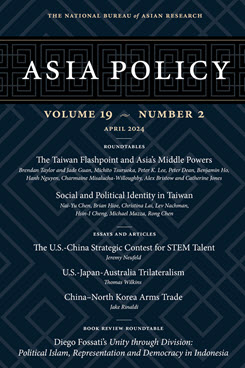Essay in Asia Policy 19.2
The Immigration Advantage in the U.S.-China Strategic Contest for STEM Talent
This essay argues that recruitment of globally mobile scientists, researchers, and inventors gives the U.S. an advantage in great-power competition with China, but one the U.S. risks squandering.
Note: This special essay was made possible by the generous support of the Hinrich Foundation.
Foreword to the Special Essay
Trade is an expression and measure of trust between people, businesses, and nations. People are at the heart of any thriving trade, and their free movement underpins the value of the intellectual exchange. If such exchanges are stymied, we place at stake a set of values in openness, democracy, and trust, all of which increasingly are the subject of an intensifying global geopolitical contest.
Jeremy Neufeld writes in this Asia Policy special essay on one of the most important aspects of this contest’s inflections: the nexus between trade, global leadership, and immigration policy. His is an eloquent disquisition on how the greatest strengths of the United States are built on the backs of immigrants, the formidable challenge mounted by China in amassing its own scientific talent, the complacency in U.S. trade and immigration policy that may prove to be the United States’ undoing, and how very high the stakes are.
Neufeld lays out data showing how China has surpassed the United States as the world’s largest source of peer-reviewed research and quantum computing. It outspends the United States in key areas of research and development. It has put in place well-financed programs to attract global talent.
China is still a distant second in most areas of science and technology competition, but it is closing the gap at warp speed. The United States, meanwhile, Neufeld writes, has lulled itself into complacency. Washington does not seem to realize that it cannot—and has never been able to—rely on domestic talent alone to retain its edge in science, technology, engineering, and mathematics (STEM).
Yet U.S. immigration policy has not kept up. The road to U.S. permanent residency remains thicketed in red tape. Visa rules discourage immigrants from joining the private sector. In a stunning statistic, Neufeld points out that in 2020 an Indian graduate with a STEM degree who applied for a U.S. green card would have to wait a projected 195 years, based on an analysis of immigration backlogs.
The United States is still the world’s top destination for immigrants. But Washington once understood their value better than it does now: the U.S. welcomed German scientists in World War II to supercharge weapons and technological research for the Pacific campaign. It spirited away Soviet talent to win the Cold War.
The Indian historian Vijay Prashad described the first postwar generation of Indian Americans as the “twice blessed”—once because they were born after Indian independence, and again because they were born after the passage of the Immigration and Nationality Act of 1965 (the Hart-Celler Act), which swept away decades of discriminatory immigration laws and sparked a surge of talented immigrants, including Indians, to U.S. shores.
The Hinrich Foundation is a philanthropy dedicated to advancing sustainable global trade. In the vortex of the global debate on the future of trade, immigration is often the forgotten stepchild. Economies that trade better are founded on openness, and that includes receptiveness toward the dreams of would-be immigrants flung across the world. Trade, after all, is about people.
Chuin Wei Yap
Program Director, International Trade Research, Hinrich Foundation
Executive Summary
MAIN ARGUMENT
The U.S. has a powerful asymmetric advantage over the People’s Republic of China in advancing its global technological leadership: the ability to draw on the top talent from around the world. The recruitment of international talent in STEM fields is a major force multiplier for U.S. scientific and technological enterprises, especially in critical and emerging technologies and defense-related industries. Attracting top international talent is not a tool that China can easily replicate. For all its efforts to lure its own émigrés back and attract international students, China is still a net emigration country, while the U.S. is the top destination for immigrants, especially scientists and inventors. However, the deteriorating conditions of legal pathways to immigration for high-skilled STEM experts threaten to undermine this strategic advantage.
POLICY IMPLICATIONS
- The U.S. is becoming less attractive for globally mobile international talent over time, largely due to the onerous and worsening conditions facing legal immigrants. Most notably, there is a mismatch between the number of people allowed to apply and receive permanent residence each year, leading to untenably long—and growing—backlogs and associated wait times.
- The U.S. could increase its innovative output by expanding the quantity and improving the quality of international STEM researchers welcomed to the country. It could do so through changes in laws and regulations or merely by better recruiting and retaining talent through increased uptake of existing programs. It could also achieve greater contributions from talent it already has recruited by removing visa barriers restricting innovation-generating activities.
- Efforts by the Chinese government to transfer technologies illicitly through espionage pose a serious risk. This risk needs to be managed with care to protect sensitive information without setting back U.S. technological development.
Jeremy Neufeld is a Senior Immigration Fellow at the Institute for Progress (United States), where he leads the immigration policy portfolio. He is also an economics PhD student at George Mason University. Previously, he was an immigration policy analyst at the Niskanen Center. His work has been cited in numerous outlets, including the Washington Post, the Wall Street Journal, and the Economist.
About Asia Policy
Asia Policy is a peer-reviewed scholarly journal presenting policy-relevant academic research on the Asia-Pacific that draws clear and concise conclusions useful to today’s policymakers. Asia Policy is published quarterly in January, April, July, and October and accepts submissions on a rolling basis. Learn more


